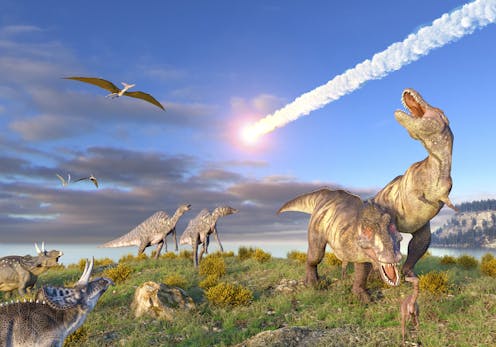How did cockroaches survive the asteroid that led to the extinction of dinosaurs?
- Written by Brian Lovett, Postdoctoral Researcher in Mycology, West Virginia University

Modern cockroaches are little survivors that can live just about anywhere on land, from the heat of the tropics to some of the coldest parts of the globe. Scientists estimate that there over 4,000 cockroach species[12].
A handful of these species like to live with humans and quickly become pests. Once cockroaches become established in a building, it’s hard to rid every little crack of these insects and their oothecae. When large numbers of roaches are present in unsanitary places, they can spread diseases. The biggest threat they pose to human health is from allergens they produce that can trigger asthma attacks and allergic reactions[13] in some people.
Cockroach pests are hard to manage because they can resist many chemical insecticides[14] and because they have the same abilities that helped their ancestors outlive many dinosaurs. Still, cockroaches are much more than a pest to control. Researchers study cockroaches to understand how they move[15] and how their bodies are designed[16] to get ideas for building better robots.
As a scientist[17], I see all insects as beautiful, six-legged inspirations. Cockroaches have already overcome odds that were too great for dinosaurs. If another meteorite hit the Earth, I’d be more worried for humans than for cockroaches.
Hello, curious kids! Do you have a question you’d like an expert to answer? Ask an adult to send your question to CuriousKidsUS@theconversation.com[18]. Please tell us your name, age and the city where you live.
And since curiosity has no age limit – adults, let us know what you’re wondering, too. We won’t be able to answer every question, but we will do our best.
References
- ^ Curious Kids (theconversation.com)
- ^ curiouskidsus@theconversation.com (theconversation.com)
- ^ Chicxulub impactor (www.nytimes.com)
- ^ triggered volcanic eruptions (theconversation.com)
- ^ except for some species (www.birdlife.org)
- ^ temperatures on Earth’s surface skyrocketed (www.smithsonianmag.com)
- ^ triggered a cascade of effects (www.livescience.com)
- ^ prefer to eat one specific plant (www.fs.fed.us)
- ^ omnivorous scavengers (cockroachfacts.com)
- ^ lay their eggs in little protective cases (extension.umn.edu)
- ^ VitalisG/iStock via Getty Images (www.gettyimages.com)
- ^ there over 4,000 cockroach species (bugguide.net)
- ^ trigger asthma attacks and allergic reactions (www.nytimes.com)
- ^ resist many chemical insecticides (www.nationalgeographic.com)
- ^ how they move (news.umich.edu)
- ^ how their bodies are designed (www.nytimes.com)
- ^ As a scientist (www.researchgate.net)
- ^ CuriousKidsUS@theconversation.com (theconversation.com)
Authors: Brian Lovett, Postdoctoral Researcher in Mycology, West Virginia University

